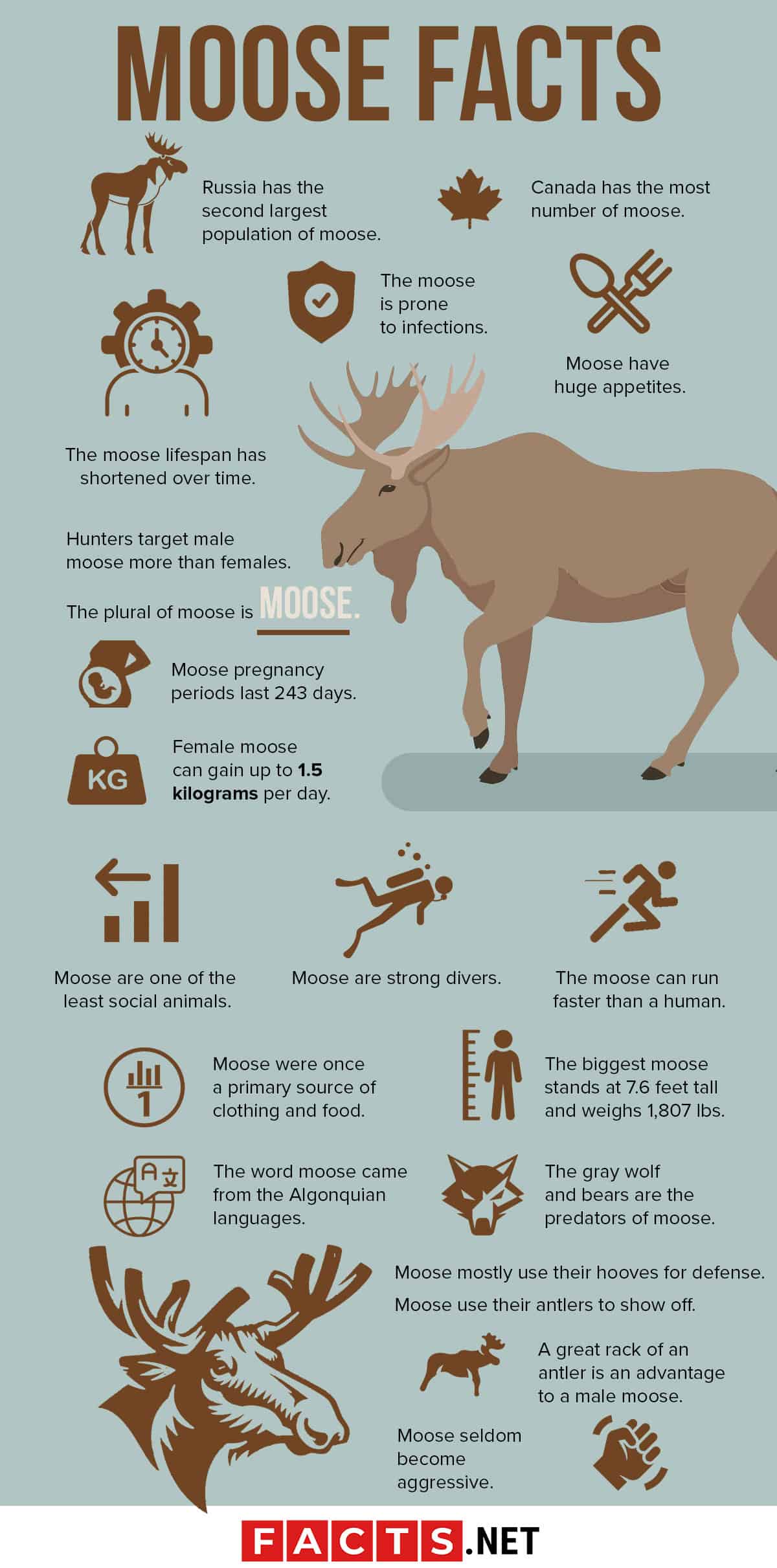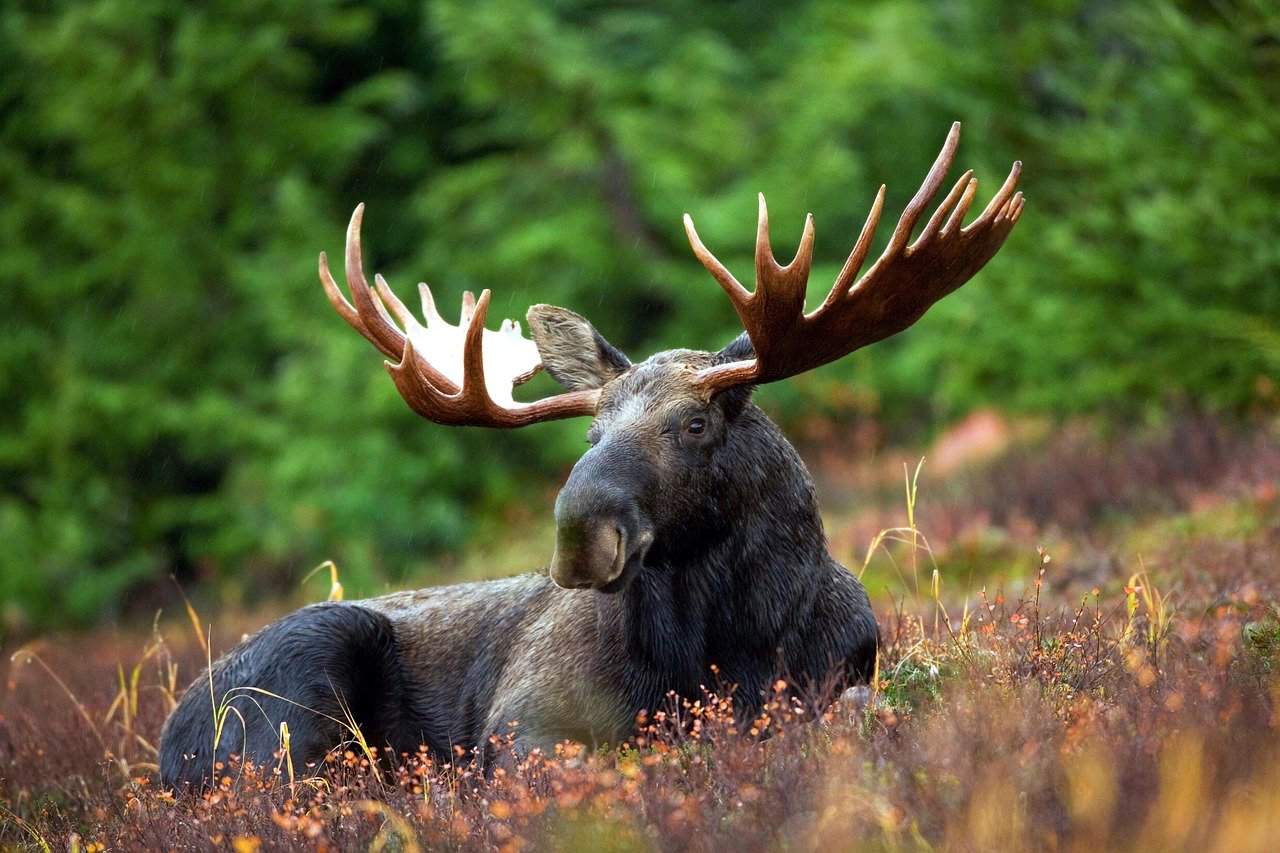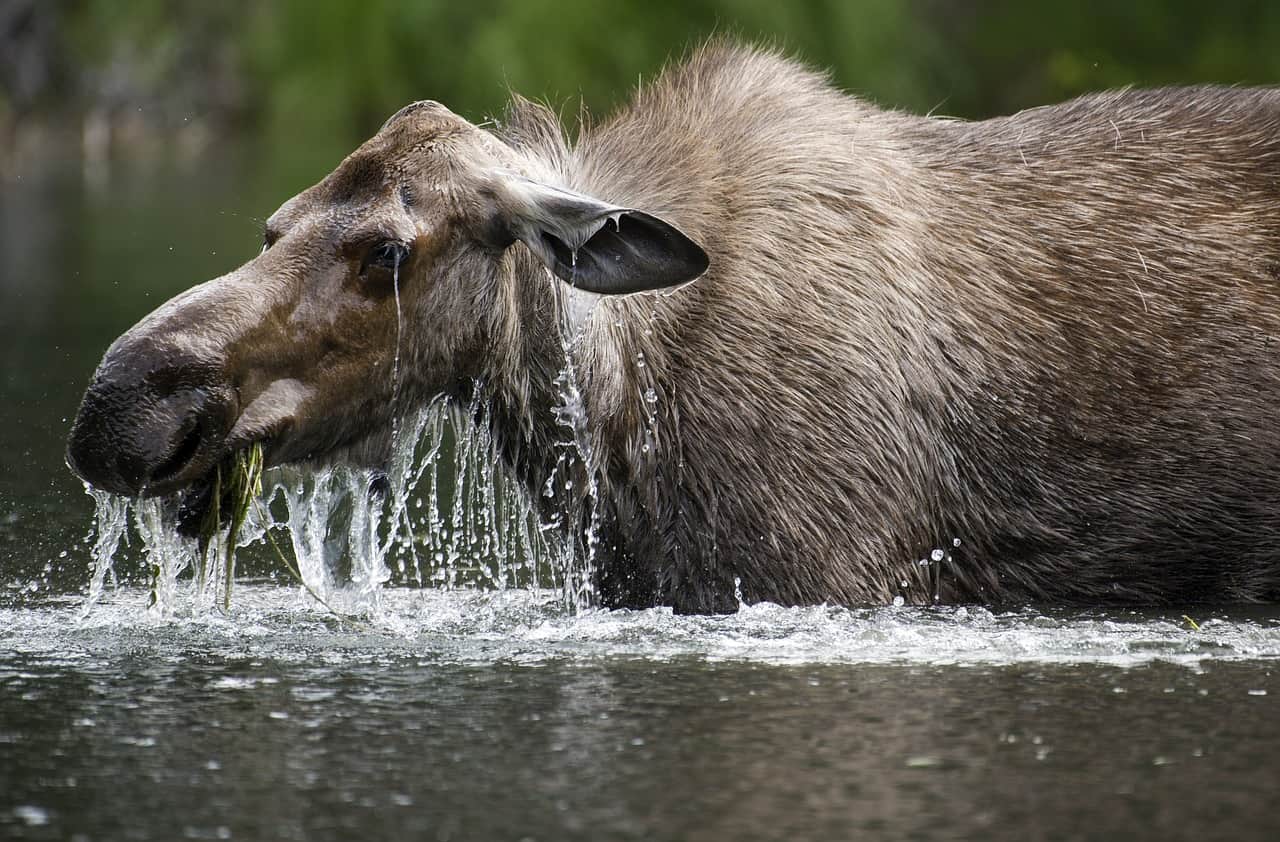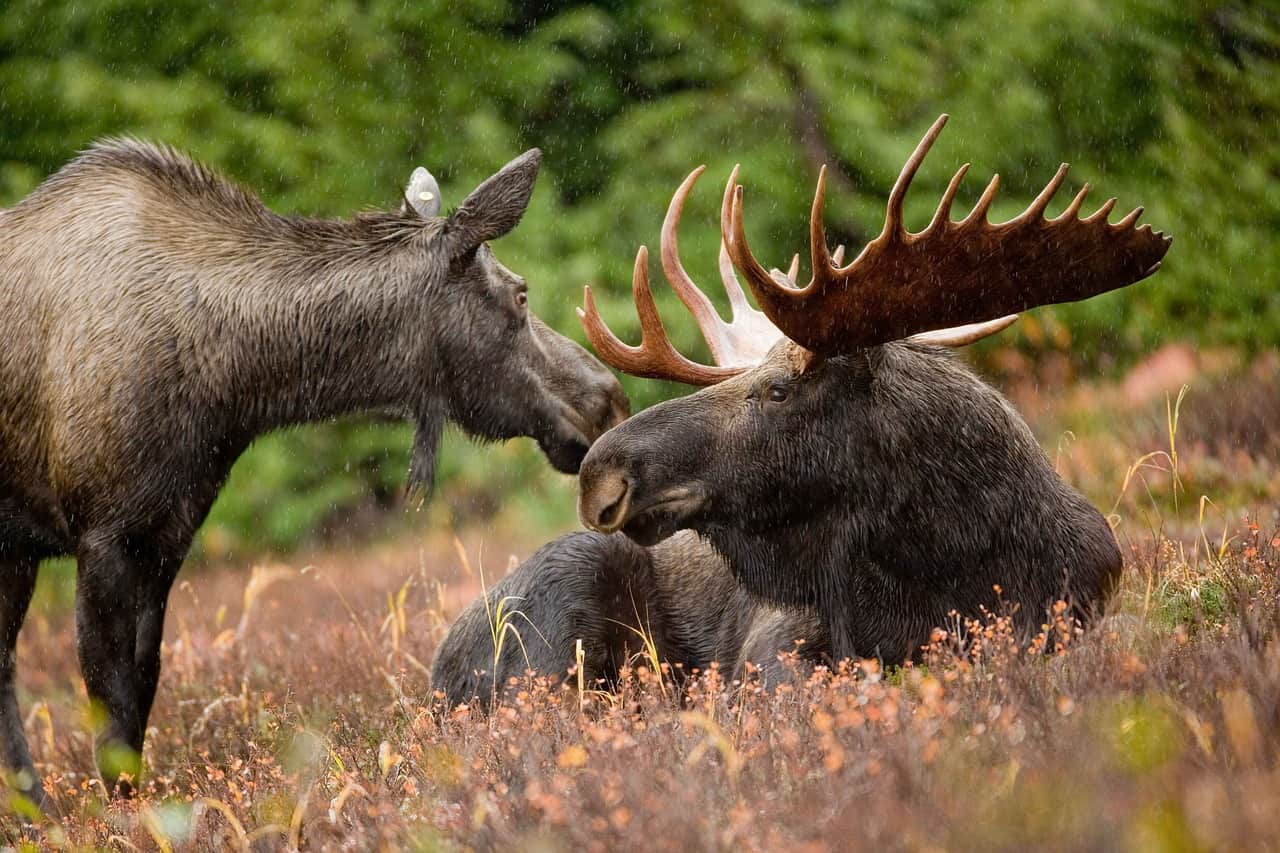
The moose is the biggest of all the deer species. Historically, this animal was an important source of clothing and food, mainly benefiting the Native Americans living along Alaska’s major rivers. However, they also pack quite the punch, weighing more than the average motorcycle. Take a closer look at these majestic animals with these moose facts.
- Adult moose can grow between 2.4 to 3.2 meters.
- The moose is the biggest and heaviest extant species in the deer family.
- Moose can run up to 35 kilometers per hour and swim up to 10 miles nonstop.
- A male’s antlers can grow up to 6 feet long.
- Moose live between 15-25 years.
- The moose’s scientific name is Alces alces.
- A moose has a big, long and bulbous nose and a “bell” beneath its throat.
- Moose normally inhabit boreal forests, as well as temperate broadleaf and mixed forests.
- In general, the male moose’s antlers have distinctive broad and open-hand shapes.
- Males are instantly recognizable by their big antlers, which can spread up to 6 feet from end to end.
- Male moose grow their antlers every year through the spring and summer season.
- Moose mostly lives in the temperate broadleaf & mixed forests and boreal forests or snow forest.
- Male moose are also called “bulls.”
- Female moose are also called “cows.”
- Moose is the state animal of Alaska.
- Female moose approximately weigh up to 360 kg, which is almost the weight of a motorcycle.
- Meanwhile, bulls or male moose weigh up to 700 kilograms.
- Female moose don’t grow antlers.
- Although the moose is not an endangered animal, hunting has affected its habitats.
- The moose’s diet is made up of both terrestrial and aquatic vegetation.
Moose Facts Infographics

Moose have huge appetites.
Typically, a moose eats around 30 pounds daily in the winter and 70 pounds in the summer. They graze on different kinds of woody plants, shrubs, bark, and water plants. During winter, they eat buds of trees and plants.

Canada has the most number of moose.
Although Canada has the most number of moose, they are also found in Alaska, New England, Fennoscandia, the Baltics (Estonia, Latvia, and Lithuania), and Russia.
Russia has the second largest population of moose.
While Canada holds around 500 thousand to 1 million moose, Russia has a moose population of around 600 thousand. This is followed by the United States and Sweden at 300,000 each.
The moose is prone to infections.
Although moose can be dangerous opponents with its huge antler and sharp hooves, they still have predators. Bears and wolves usually pick off young, sick, and old moose. A single bite from these predators can cause infections that can kill even a healthy adult moose within two weeks.
The moose lifespan has shortened over time.
Although moose can normally live up to 25 years, most moose today only tend to live around 10 years due to intensive hunting by humans.
Hunters target male moose more than females.
Compared to the female moose or cows, the male moose or bulls are the main target of the hunters. As a result, only up to 10% of the bulls reach the age of 5 years while cows generally live 10 to 20 years old.
The plural of moose is moose.
The only correct plural form of moose is moose. Sometimes, people mistakenly think that its plural is “Moses” or “Meese,” but this is actually not the case.
Moose pregnancy periods last 243 days.
The moose’s babies are called calves. In general, the moose’s pregnancy period lasts 243 days. Cows normally give birth to one or two calves, with a maximum of three in rare occasions.
Female moose can gain up to 1.5 kilograms per day.
At birth, the moose’s calf weighs approximately 8-15 kilograms. During the first few months, they gain 1.5 kilograms a day. A pregnant moose’s reddish fur transforms into brown after about 2.5 months.
The gray wolf and bears are the predators of moose.
Aside from hunters, the other predators of moose are the gray wolf and bears. The gray wolf lives today in various environments such as mountain areas, woodlands, forests, tundra, grasslands, and even deserts. In Alaska, there are around 7,000 to 11,000 wolves that hunt not just moose but also caribou, dall sheep, squirrels, snowshoe hares, and beavers.
Moose are one of the least social animals.
In contrast to other deer species, moose do not join herds. For the most part, moose are solitary animals, except for calves that remain with their mother until they no longer need them. Other than that, moose only socialize during mating season. How’s that for relatable moose facts?
Moose are strong divers.
Moose can dive approximately 6 meters or 20 feet deep. They do this to reach the aquatic plants at the bottom of rivers and lakes. They also use their big nostrils as valves that keep the water out when diving, which is comparable to a snorkel.

Moose were once a primary source of clothing and food.
It may sound like one of the less believable moose facts, but moose were consistently hunted for sustenance that their numbers declined by the mid-1800s. This was also because of the lack of laws protecting the species. Today, hunting moose is still legal in the United States but with heavy regulations.
The biggest moose stands at 7.6 feet tall and weighs 1,807 lbs.
The biggest moose that was ever hunted in Alaska was recorded in September 1897, in Western Yukon. The moose was 7.6 feet tall at the shoulder and it weighs 820 kilograms or 1,807 lbs.
The moose can run faster than a human.
Despite weighing more than the average motorcycle, moose can run as fast as 56 kilometers per hour. Furthermore, they can also swim 16 kilometers without stopping.
This makes moose significantly faster than the Olympic gold medalist sprinter Usain Bolt, who holds the record for the fastest man alive at a speed of 44.64 kilometers per hour.
The word moose came from the Algonquian languages.
Moose are called ‘moose’ in North American English, while it’s called ‘elk’ in British English. The term ‘moose’ had first entered English by 1606, rooting from the Algonquian language.
Moose mostly use their hooves for defense.
The moose’s huge antlers may look like their main weapon, but they mostly use their sharp hooves to fight off the predators. Combined with their weight and agility, moose are capable of seriously wounding a bear or wolf with their sharp hooves.
Moose use their antlers to show off.
During moos mating season in autumn, males use their antlers to fight with other bull moose to show off to potential mates. Bulls are seen this time scattered throughout the land looking for a female mate and establishing breeding territory.
A great rack of an antler is an advantage to a male moose.
Moose fights are not always fight-to-death scenarios. During a fight, the competing moose usually backs-out if the challenger has a greater rack of antlers. It is also easier to attract a mate with impressive antlers.
Antlers can weigh more than 35 pounds.
The moose’s antlers are composed of bone, with the males developing muscular necks to help hold up these huge antlers. A full-grown moose’s antlers can weigh more than 35 pounds.
Antlers sell for approximately $10 to $15 per pound.
Depending on their size, the moose’s antlers sell for approximately $10 to $15 per pound. The larger the antlers, the more expensive it gets.
Moose meat is high in protein and low in calories.
Moose meat is perfect if you’re on a bulk protein diet. Moose meat only has 100 calories for every 100-gram serving and above all, with a hefty 22 grams of protein and essential amino acids that are good for the body.
Moose meat is high in potassium.
Aside from the fact that moose is high in protein, its meat is also filled with vitamins and minerals. The meat doesn’t have much fat in it and is very low in sodium yet high in potassium.
The moose thrives in cold places.
Moose are cold-adapted mammals with thick skin, a dense, heat-retaining coat which provides them a superior cold tolerance. Although on the flip side, moose have a poor heat tolerance.
Adult moose can withstand temperatures lower than -30°C.
Although calves or baby moose start to feel the cold at -30°C, fully-grown moose can withstand far colder temperatures. Even more, on warmer winter days, they would lie in the snow to cool down. Definitely one of the cooler moose facts.

Moose bask in bodies of water when it's hot.
During hot weather, the moose can survive by going to shaded areas and the coolest places possible. They also bathe in cool water and often walk or swim in lakes, rivers, and ponds.
Moose have four-chambered stomachs.
Like cows, moose have four-chambered stomachs. When feeding, moose partially regurgitate its digested food and chew the softened mixture. The food is fermented in the moose stomach’s first chamber, while the nutrients are extracted in the next three.
Moose seldom become aggressive.
Along with their solitary nature, moose are rarely aggressive. However, they will protect themselves if threatened and can easily be provoked during the mating season. Moose’s usual aggressive action is the act of “pretending,” where they bluff an attack so they can stay safe without the need to fight.
Male moose have dewlaps.
Dewlaps are the dangling flaps under their chins. Bulls rub these on cows to scent mark them during mating season. The size of the dewlap may also indicate a moose’s dominance level.
Was this page helpful?
Our commitment to delivering trustworthy and engaging content is at the heart of what we do. Each fact on our site is contributed by real users like you, bringing a wealth of diverse insights and information. To ensure the highest standards of accuracy and reliability, our dedicated editors meticulously review each submission. This process guarantees that the facts we share are not only fascinating but also credible. Trust in our commitment to quality and authenticity as you explore and learn with us.
